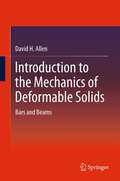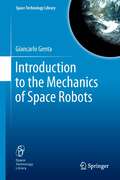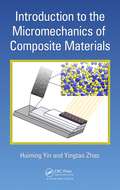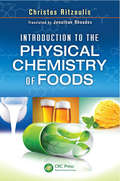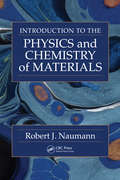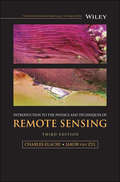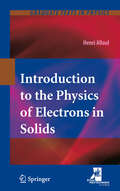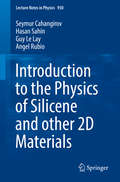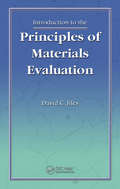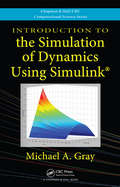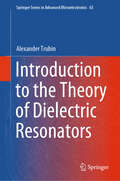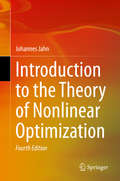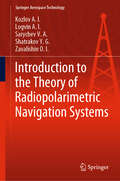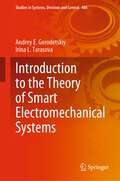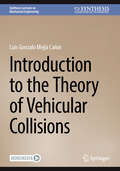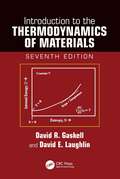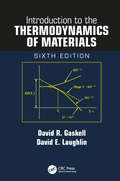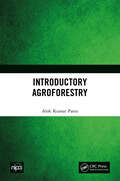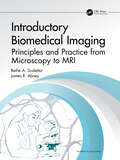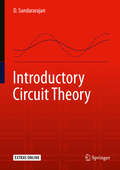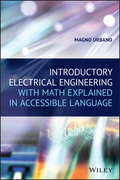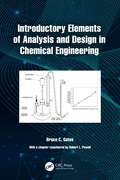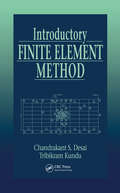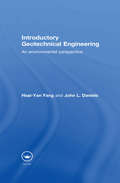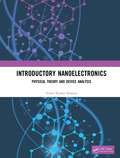- Table View
- List View
Introduction to the Mechanics of Deformable Solids
by David H. AllenIntroduction to the Mechanics of Deformable Solids: Bars and Beams introduces the theory of beams and bars, including axial, torsion, and bending loading and analysis of bars that are subjected to combined loadings, including resulting complex stress states using Mohr's circle. The book provides failure analysis based on maximum stress criteria and introduces design using models developed in the text. Throughout the book, the author emphasizes fundamentals, including consistent mathematical notation. The author also presents the fundamentals of the mechanics of solids in such a way that the beginning student is able to progress directly to a follow-up course that utilizes two- and three-dimensional finite element codes imbedded within modern software packages for structural design purposes. As such, excessive details included in the previous generation of textbooks on the subject are obviated due to their obsolescence with the availability of today's finite element software packages.
Introduction to the Mechanics of Space Robots
by Giancarlo GentaBased on lecture notes on a space robotics course, this book offers a pedagogical introduction to the mechanics of space robots. After presenting an overview of the environments and conditions space robots have to work in, the author discusses a variety of manipulatory devices robots may use to perform their tasks. This is followed by a discussion of robot mobility in these environments and the various technical approaches. The last two chapters are dedicated to actuators, sensors and power systems used in space robots. This book fills a gap in the space technology literature and will be useful for students and for those who have an interest in the broad and highly interdisciplinary field of space robotics, and in particular in its mechanical aspects.
Introduction to the Micromechanics of Composite Materials
by Huiming Yin Yingtao ZhaoPresents Concepts That Can Be Used in Design, Processing, Testing, and Control of Composite MaterialsIntroduction to the Micromechanics of Composite Materials weaves together the basic concepts, mathematical fundamentals, and formulations of micromechanics into a systemic approach for understanding and modeling the effective material behavior of co
Introduction to the Physical Chemistry of Foods
by Christos RitzoulisIntroduction to the Physical Chemistry of Foods provides an easy-to-understand text that encompasses the basic principles of physical chemistry and their relationship to foods and their processing. Based on the author's years of teaching and research experience in the physical chemistry of food, this book offers the necessary depth of information a
Introduction to the Physics and Chemistry of Materials
by Robert J. NaumannDiscusses the Structure and Properties of Materials and How These Materials Are Used in Diverse ApplicationsBuilding on undergraduate students' backgrounds in mathematics, science, and engineering, Introduction to the Physics and Chemistry of Materials provides the foundation needed for more advanced work in materials science. Ideal for a two-semes
Introduction to the Physics and Techniques of Remote Sensing (Wiley Series in Remote Sensing and Image Processing #28)
by Jakob J. van Zyl Charles ElachiDiscover cutting edge theory and applications of modern remote sensing in geology, oceanography, atmospheric science, ionospheric studies, and more The thoroughly revised third edition of the Introduction to the Physics and Techniques of Remote Sensing delivers a comprehensive update to the authoritative textbook, offering readers new sections on radar interferometry, radar stereo, and planetary radar. It explores new techniques in imaging spectroscopy and large optics used in Earth orbiting, planetary, and astrophysics missions. It also describes remote sensing instruments on, as well as data acquired with, the most recent Earth and space missions. Readers will benefit from the brand new and up-to-date concept examples and full-color photography, 50% of which is new to the series. You’ll learn about the basic physics of wave/matter interactions, techniques of remote sensing across the electromagnetic spectrum (from ultraviolet to microwave), and the concepts behind the remote sensing techniques used today and those planned for the future. The book also discusses the applications of remote sensing for a wide variety of earth and planetary atmosphere and surface sciences, like geology, oceanography, resource observation, atmospheric sciences, and ionospheric studies. This new edition also incorporates: A fulsome introduction to the nature and properties of electromagnetic waves An exploration of sensing solid surfaces in the visible and near infrared spectrums, as well as thermal infrared, microwave, and radio frequencies A treatment of ocean surface sensing, including ocean surface imaging and the mapping of ocean topography A discussion of the basic principles of atmospheric sensing and radiative transfer, including the radiative transfer equation Perfect for senior undergraduate and graduate students in the field of remote sensing instrument development, data analysis, and data utilization, Introduction to the Physics and Techniques of Remote Sensing will also earn a place in the libraries of students, faculty, researchers, engineers, and practitioners in fields like aerospace, electrical engineering, and astronomy.
Introduction to the Physics of Electrons in Solids
by Henri Alloul Stephen LyleThis textbook sets out to enable readers to understand fundamental aspects underlying quantum macroscopic phenomena in solids, primarily through the modern experimental techniques and results. The classic independent-electrons approach for describing the electronic structure in terms of energy bands helps explain the occurrence of metals, insulators and semiconductors. It is underlined that superconductivity and magnetism can only be understood by taking into account the interactions between electrons. The text recounts the experimental observations that have revealed the main properties of the superconductors and were essential to track its physical origin. While fundamental concepts are underlined, those which are required to describe the high technology applications, present or future, are emphasized as well. Problem sets involve experimental approaches and tools which support a practical understanding of the materials and their behaviour.
Introduction to the Physics of Silicene and other 2D Materials
by Angel Rubio Seymur Cahangirov Hasan Sahin Guy Le LayThis concise book offers an essential introduction and reference guide for the many newcomers to the field of physics of elemental 2D materials. Silicene and related materials are currently among the most actively studied materials, especially following the first experimental synthesis on substrates in 2012. Accordingly, this primer introduces and reviews the most crucial developments regarding silicene from both theoretical and experimental perspectives. At the same time the reader is guided through the extensive body of relevant foundational literature. The text starts with a brief history of silicene, followed by a comparison of the bonding nature in silicon versus carbon atoms. Here, a simple but robust framework is established to help the reader follow the concepts presented throughout the book. The book then presents the atomic and electronic structure of free-standing silicene, followed by an account of the experimental realization of silicene on substrates. This topic is subsequently developed further to discuss various reconstructions that silicene acquires due to interactions with the substrate and how such effects are mirrored in the electronic properties. Next the book examines the dumbbell structure that is the key to understanding the growth mechanism and atomic structure of multilayer silicene. Last but not least, it addresses similar effects in other elemental 2D materials from group IV (germanene, stanane), group V (phosphorene) and group III (borophene), as well as transition metal dichalcogenides and other compositions, so as to provide a general comparative overview of their electronic properties.
Introduction to the Principles of Materials Evaluation
by David C. JilesChoosing the proper material testing technique is important not just for economic reasons; in many circumstances, it can save lives. Building on the common links among all types of material evaluation methods, Introduction to the Principles of Materials Evaluation presents a thorough examination of all types of destructive and nondestructive
Introduction to the Simulation of Dynamics Using Simulink (Chapman & Hall/CRC Computational Science)
by Michael A. GrayDesigned for undergraduate students in the general science, engineering, and mathematics community, Introduction to the Simulation of Dynamics Using Simulink (R) shows how to use the powerful tool of Simulink to investigate and form intuitions about the behavior of dynamical systems. Requiring no prior programming experience, it clearly explains how to transition from physical models described by mathematical equations directly to executable Simulink simulations.Teaches students how to model and explore the dynamics of systemsStep by step, the author presents the basics of building a simulation in Simulink. He begins with finite difference equations and simple discrete models, such as annual population models, to introduce the concept of state. The text then covers ordinary differential equations, numerical integration algorithms, and time-step simulation. The final chapter offers overviews of some advanced topics, including the simulation of chaotic dynamics and partial differential equations.A one-semester undergraduate course on simulationWritten in an informal, accessible style, this guide includes many diagrams and graphics as well as exercises embedded within the text. It also draws on numerous examples from the science, engineering, and technology fields. The book deepens students' understanding of simulated systems and prepares them for advanced and specialized studies in simulation.
Introduction to the Theory of Dielectric Resonators (Springer Series in Advanced Microelectronics #65)
by Alexander TrubinEmbark on a comprehensive exploration of high-Q dielectric resonators. The book covers various shapes, introducing innovative scattering theories and new perspectives on coupling coefficients. It breaks ground by investigating coupled oscillations in diverse resonator types, shapes, and dielectrics, extending to frequency-detuned resonators and lattice formations. The revolutionary S-matrix methodology is presented with practical applications, including complex structures like optical microcavities. The book concludes by delving into the time domain, exploring pulse scattering and radiation by antenna arrays of dielectric resonators. Primarily targeted at researchers, engineers, and students in electromagnetics, materials science, and physics. This work uniquely combines theoretical depth with practical applications in high-Q dielectric resonators.
Introduction to the Theory of Nonlinear Optimization
by Johannes JahnThis book serves as an introductory text to optimization theory in normed spaces and covers all areas of nonlinear optimization. It presents fundamentals with particular emphasis on the application to problems in the calculus of variations, approximation and optimal control theory. The reader is expected to have a basic knowledge of linear functional analysis.
Introduction to the Theory of Radiopolarimetric Navigation Systems (Springer Aerospace Technology)
by Shatrakov Y.G. Zavalishin O.I. Kozlov A.I. Logvin A.I. Sarychev V.A.The book highlights three types of technologies being developed for autonomous solution of navigation problems. These technologies are based on the polarization structure, ultra-broadband and the fluctuation characteristics (slow and fast) of the radiolocation signals. The book presents the problems of intrinsic thermal radio emission polarization and change in radio waves polarization when they are reflected from objects with non-linear properties.The purpose of this book is to develop the foundations for creating autonomous radionavigation systems to provide aviation with navigation systems that will substantially increase its capabilities, specifically acting where satellite technologies do not work. The book is intended for specialists involved in the development and operation of aviation-technical complexes, as well as for specialists of national aviation regulators and ICAO experts dealing with the problems of improving flight safety.
Introduction to the Theory of Smart Electromechanical Systems (Studies in Systems, Decision and Control #486)
by Andrey E. Gorodetskiy Irina L. TarasovaThis book aims to familiarize with the basics of the SEMS theory, including logical-probabilistic and logical-linguistic methods for their design and modeling, taking into account the incomplete certainty of the operating environment and the mental characteristics of the members of the human–machine systems collective. Smart electromechanical systems (SEMS) are used in cyber-physical systems (CPS). The main tasks in the field of theory and practice of CPS are to ensure the efficiency, reliability and safety of operation in real time.SEMS have been widely used since 2000 in parallel robots or so-called parallel kinematic machines. They offer good opportunities in terms of precision, rigidity and the ability to handle heavy loads. SEMS are used in unmanned vehicles, astronomy, machine tools, medicine and other fields.Currently, much attention is paid to the methods of designing and modeling SEMS based on the principles of adaptability, intelligence, biomorphism of parallel kinematics and parallelism in information processing and control calculations. The book consists of four parts:- Mechanisms and control systems;- The central nervous system;- Group control;- Examples of using SEMS modules.The book is recommended for specialists in the field of control, as well as a textbook for masters of universities specializing in the field of smart electromechanical systems and robotics and includes many scientific fields such as kinematics, dynamics and control theory.
Introduction to the Theory of Vehicular Collisions (Synthesis Lectures on Mechanical Engineering)
by Luis Gonzalo Mejía CañasThe phenomena that occur during a vehicle collision are extremely complex, to such an extent that car manufacturers are forced to carry out full-scale tests in order to draw conclusions about vehicle behavior. Fortunately, for the engineering calculations required in a collision analysis, equations can be considered, which, with reasonable development, and with good judgment, lead to reliable results. This book seeks to take a first step on the exciting topic of the Theory of Vehicular Collisions, because this field of science has crucial importance, for example, in clarifying circumstances of serious criminal and civil penalties situations. A brief historical review about the development of collisions theory is also included.
Introduction to the Thermodynamics of Materials
by David R. Gaskell David E. LaughlinMaintaining the substance that has made Introduction to the Thermodynamics of Materials a perennial bestseller for decades, the Seventh Edition is updated to reflect the broadening field of materials science and engineering. Chapters are updated and revised throughout to be more useful and logical for students. Features more than 60 new homework problems for the students, a listing of terms and concepts introduced, and a summary section Includes more on mathematical and graphical analysis of the various state functions utilized in classical thermodynamics Includes a more extensive discussion of the third law of thermodynamics Features a new appendix on exact differential equations and mathematical relationships, including all mathematical relations among differentials of homogeneous functions utilized in the text Written as the definitive introduction to the thermodynamic behavior of materials systems, this text presents the underlying thermodynamic principles of materials and their applications and continues to be the best undergraduate textbook in thermodynamics for materials science students. An updated solutions manual is also available for qualifying adopting professors.
Introduction to the Thermodynamics of Materials (6th Edition)
by David R. Gaskell David E. LaughlinMaintaining the substance that made Introduction to the Thermodynamic of Materials a perennial best seller for decades, this Sixth Edition is updated to reflect the broadening field of materials science and engineering. The new edition is reorganized into three major sections to align the book for practical coursework, with the first (Thermodynamic Principles) and second (Phase Equilibria) sections aimed at use in a one semester undergraduate course. The third section (Reactions and Transformations) can be used in other courses of the curriculum that deal with oxidation, energy, and phase transformations. The book is updated to include the role of work terms other than PV work (e.g., magnetic work) along with their attendant aspects of entropy, Maxwell equations, and the role of such applied fields on phase diagrams. There is also an increased emphasis on the thermodynamics of phase transformations and the Sixth Edition features an entirely new chapter 15 that links specific thermodynamic applications to the study of phase transformations. The book also features more than 50 new end of chapter problems and more than 50 new figures.
Introductory Agroforestry
by Alok Kumar PatraThe origin of agroforestry practices—growing trees and shrubs with food and fruit crops and grasses is traditional and very old—but the science of agroforestry is new. Years of experience and experiments have shown that agroforestry as a land-use system is capable of yielding both food and wood and at the same time helps in conserving and rehabilitating the ecosystems. It has the capability to increase the overall productivity of land, maintain the nutrient balance in the soil, and above all, protect the nature. In the recent years, agroforestry has been recommended as a core subject in the curriculum of B. Sc. (Forestry) and B. Sc. (Agriculture) courses of agricultural universities. This book has been divided into ten chapters covering very comprehensive information on all aspects of agroforestry including history, concepts, systems classification, tree-crop interactions, planning and management, diagnosis and design, policy and projects, and propagation and management practices of multipurpose trees. This book is co-published with NIPA. Taylor and Francis does not sell or distribute its print and electronic editions in India, Pakistan, Nepal, Bhutan, Bangladesh and Sri Lanka.
Introductory Biomedical Imaging: Principles and Practice from Microscopy to MRI (Imaging in Medical Diagnosis and Therapy)
by Bethe A. Scalettar James R. AbneyImaging is everywhere. We use our eyes to see and cameras to take pictures. Scientists use microscopes and telescopes to peer into cells and out to space. Doctors use ultrasound, X-rays, radioisotopes, and MRI to look inside our bodies. If you are curious about imaging, open this textbook to learn the fundamentals. Imaging is a powerful tool in fundamental and applied scientific research and also plays a crucial role in medical diagnostics, treatment, and research. This undergraduate textbook introduces cutting-edge imaging techniques and the physics underlying them. Elementary concepts from electromagnetism, optics, and modern physics are used to explain prominent forms of light microscopy, as well as endoscopy, ultrasound, projection radiography and computed tomography, radionuclide imaging, and magnetic resonance imaging. This textbook also covers digital image processing and analysis. Theoretical principles are reinforced with illustrative homework problems, applications, activities, and experiments, and by emphasizing recurring themes, including the effects of resolution, contrast, and noise on image quality. Readers will learn imaging fundamentals, diagnostic capabilities, and strengths and weaknesses of techniques. This textbook had its genesis, and has been vetted, in a "Biomedical Imaging" course at Lewis & Clark College in Portland, OR, and is designed to facilitate the teaching of similar courses at other institutions. It is unique in its coverage of both optical microscopy and medical imaging at an intermediate level, and exceptional in its coverage of material at several levels of sophistication.
Introductory Circuit Theory
by D. SundararajanThis textbook for a one-semester course in Electrical Circuit Theory is written to be concise, understandable, and applicable. Matlab is used throughout, for coding the programs and simulation of the circuits. Every new concept is illustrated with numerous examples and figures, in order to facilitate learning. The simple and clear style of presentation, along with comprehensive coverage, enables students to gain a solid foundation in the subject, along with the ability to apply techniques to real circuit analysis. Written to be accessible to students of varying backgrounds, this textbook presents the analysis of realistic, working circuitsPresents concepts in a clear, concise and comprehensive manner, such as the difficult problem of setting up the equilibrium equations of circuits using a systematic approach in a few distinct stepsIncludes worked examples of functioning circuits, throughout every chapter, with an emphasis on real applicationsIncludes numerous exercises at the end of each chapter Provides program scripts and circuit simulations, using the popular and widely used Matlab software, as supplementary material online
Introductory Electrical Engineering With Math Explained in Accessible Language: Math Foundation Explained
by Magno UrbanoOffers an understanding of the theoretical principles in electronic engineering, in clear and understandable terms Introductory Electrical Engineering With Math Explained in Accessible Language offers a text that explores the basic concepts and principles of electrical engineering. The author—a noted expert on the topic—explains the underlying mathematics involved in electrical engineering through the use of examples that help with an understanding of the theory. The text contains clear explanations of the mathematical theory that is needed to understand every topic presented, which will aid students in engineering courses who may lack the necessary basic math knowledge. Designed to breakdown complex math concepts into understandable terms, the book incorporates several math tricks and knowledge such as matrices determinant and multiplication. The author also explains how certain mathematical formulas are derived. In addition, the text includes tables of integrals and other tables to help, for example, find resistors’ and capacitors’ values. The author provides the accessible language, examples, and images that make the topic accessible and understandable. This important book: • Contains discussion of concepts that go from the basic to the complex, always using simplified language • Provides examples, diagrams, and illustrations that work to enhance explanations • Explains the mathematical knowledge that is crucial to understanding electrical concepts • Contains both solved exercises in-line with the explanations Written for students, electronic hobbyists and technicians, Introductory Electrical Engineering With Math Explained in Accessible Language is a much-needed text that is filled with the basics concepts of electrical engineering with the approachable math that aids in an understanding of the topic.
Introductory Elements of Analysis and Design in Chemical Engineering
by Bruce C. Gates Robert L. PowellIntroductory Elements of Analysis and Design in Chemical Engineering introduces readers to how chemical engineers think. It explains the application of analytical methods to phenomena important in chemical engineering and teaches analytical skills in the context of engineering design. A principle goal is to help readers reinforce their understanding of mathematics (especially calculus) and science as they are introduced to engineering thinking. Key Features: • Emphasizes basic principles, methods, and problem solving at an elementary level. • Presents concepts in calculus, chemistry, and physics and methods of analysis on the basis of experiment and observation. • Connects experimental results to mathematical representations. • Provides numerous illustrative examples and builds on them to introduce processing and process flow diagrams and to place chemical engineering in an historical context. • Includes problems at the end of each chapter. Aimed at readers beginning their studies in chemical engineering, this textbook offers an approachable introduction to the principles of analysis and design in chemical engineering to help readers learn to think quantitatively and with a foundation of chemical engineering concepts.
Introductory Finite Element Method (Mechanical and Aerospace Engineering Series)
by Tribikram Kundu Chandrakant S. DesaiAlthough there are many books on the finite element method (FEM) on the market, very few present its basic formulation in a simple, unified manner. Furthermore, many of the available texts address either only structure-related problems or only fluid or heat-flow problems, and those that explore both do so at an advanced level.Introductory Finite Element Method examines both structural analysis and flow (heat and fluid) applications in a presentation specifically designed for upper-level undergraduate and beginning graduate students, both within and outside of the engineering disciplines. It includes a chapter on variational calculus, clearly presented to show how the functionals for structural analysis and flow problems are formulated. The authors provide both one- and two-dimensional finite element codes and a wide range of examples and exercises. The exercises include some simpler ones to solve by hand calculation-this allows readers to understand the theory and assimilate the details of the steps in formulating computer implementations of the method.Anyone interested in learning to solve boundary value problems numerically deserves a straightforward and practical introduction to the powerful FEM. Its clear, simplified presentation and attention to both flow and structural problems make Introductory Finite Element Method the ideal gateway to using the FEM in a variety of applications.
Introductory Geotechnical Engineering: An Environmental Perspective
by Hsai-Yang Fang John L. DanielsIntegrating and blending traditional theory with particle-energy-field theory, this book provides a framework for the analysis of soil behaviour under varied environmental conditions. This book explains the why and how of geotechnical engineering in an environmental context. Using both SI and Imperial units, the authors cover: rock mechanics soil mechanics and hydrogeology soil properties and classifications and issues relating to contaminated land. Students of civil, geotechnical and environmental engineering and practitioners unfamiliar with the particle-energy-field concept, will find that this book's novel approach helps to clarify the complex theory behind geotechnics.
Introductory Nanoelectronics: Physical Theory and Device Analysis
by Vinod Kumar KhannaThis introductory text develops the reader’s fundamental understanding of core principles and experimental aspects underlying the operation of nanoelectronic devices. The author makes a thorough and systematic presentation of electron transport in quantum-confined systems such as quantum dots, quantum wires, and quantum wells together with Landauer-Büttiker formalism and non-equilibrium Green’s function approach. The coverage encompasses nanofabrication techniques and characterization tools followed by a comprehensive exposition of nanoelectronic devices including resonant tunneling diodes, nanoscale MOSFETs, carbon nanotube FETs, high-electron-mobility transistors, single-electron transistors, and heterostructure optoelectronic devices. The writing throughout is simple and straightforward, with clearly drawn illustrations and extensive self-study exercises for each chapter. Introduces the basic concepts underlying the operation of nanoelectronic devices. Offers a broad overview of the field, including state-of-the-art developments. Covers the relevant quantum and solid-state physics and nanoelectronic device principles. Written in lucid language with accessible mathematical treatment. Includes extensive end-of-chapter exercises and many insightful diagrams.
